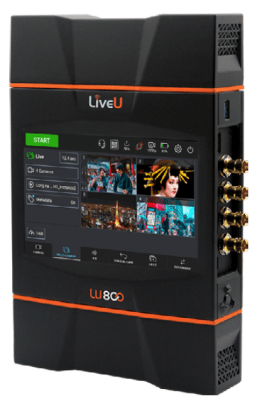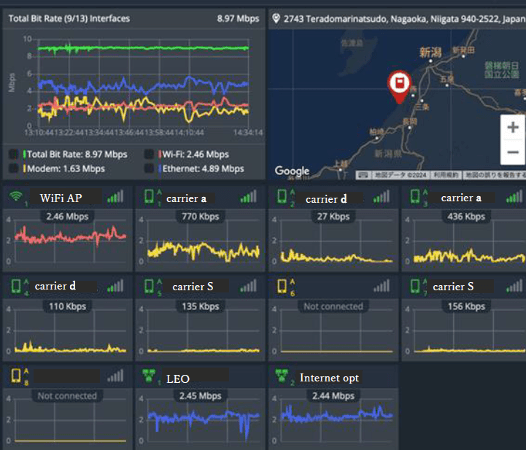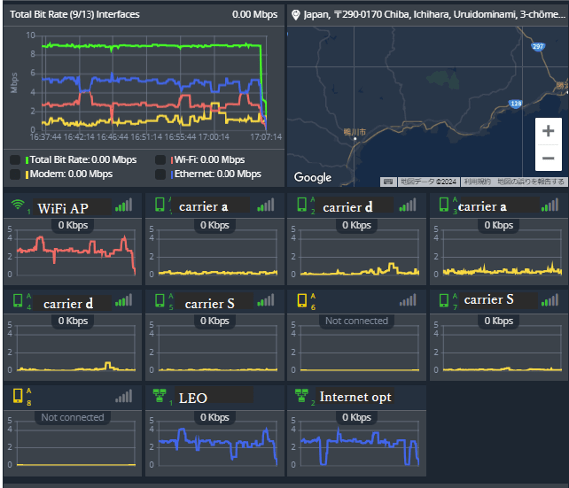TV Tokyo Research: Using LiveU Encoders as a Primary Broadcasting Solution
This study investigates the effectiveness of using different network types (satellite, cellular, internet through WiFi and Ethernet) for live TV program transmission, with a focus on the role of LiveU bonding technology in stabilizing feed transmissions. Based on TV Tokyo’s analysis, LiveU’s bonding technology plays a pivotal role in stabilizing these connections and can serve as a primary solution ensuring reliable and high-quality broadcasts.

Test Set-Up and Scenarios:
- Hardware: LU800
- Locations: Multiple geographical locations with varying network conditions across Japan
- Individual connection performance: Testing each network type individually
Individual Connection Performance
Satellite – Low Earth Orbit (LEO) Network
Multiple tests were conducted in various locations across Japan. Some installations were set up in ideal conditions with no obstructions, while others had obstructions in the line of sight to the LEO satellite. Even in installations with optimal line-of-sight conditions, the transmission rate experienced frequent and significant fluctuations during the 30-minute testing period, regardless of the delay setting. As you can see from the graphs below, transmission rate drops were often larger than 50%, with several instances of video disruptions. In obstructed areas, in addition to rate drops, the connection was frequently lost.

The frequent drops and disconnections in the LEO satellite network make it a risky choice for live program transmission, even under ideal conditions.
Ethernet/WiFi
Tests were conducted in various locations with different network infrastructures, evaluating performance under varying network loads and bandwidth limitations. These helped understand the impact of network infrastructure and bandwidth availability on Ethernet and WiFi transmission quality. While fixed internet is primarily used for broadcast transmission, TV Tokyo also conducted tests where fixed internet was unstable.

A fixed internet connection with drops and disconnections can be a risky choice for live program transmission if it has not been tested beforehand.
Cellular Connection
TV Tokyo conducted various tests across Japan, both in areas with clear coverage and good signal strength, as well as in congested areas with poor cellular coverage.
As you can see in the graphs below, each single connection experiences multiple bandwidth drops.

Although the overall bonded connection offers a balance between coverage and performance, the frequent drops and limited bandwidth can make them challenging for live TV transmission.
Bonded Connection
After looking at each connectivity type individually, TV Tokyo examined how LiveU IP bonding technology performs in various scenarios, ranging from optimal conditions to congested areas with poor cellular and optical connections.
In the following graph, even with poor cellular networks and interruptions in the LEO satellite connection, there were no significant drops in the overall bitrate.

TV Tokyo further tested LiveU’s bonded connection by using it during a sports event in a crowded area with poor cellular coverage and unstable fixed internet connections.

The crowded audience significantly impacted the cellular network’s communication capabilities. The internet lines – both WiFi and LAN-connected optical fiber – experienced frequent fluctuations. Additionally, the LEO network encountered an unusual drop. Despite these issues, the overall data rate remained stable, ensuring uninterrupted high-quality video and audio transmission.
Conclusion
The study demonstrates that public networks can be a viable option for live TV program transmission when combined with effective tools and strategies. LiveU’s bonding technology plays a pivotal role in stabilizing these connections, ensuring reliable and high-quality broadcasts. Furthermore, LiveU units can be used as a primary solution. Overall, it works efficiently compared to costly satellite or fiber connections and is expected to improve the cost efficiency of the workflow.

